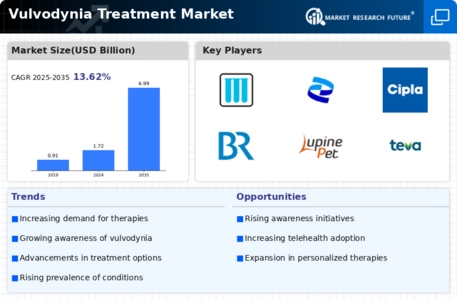Rising Incidence of Vulvodynia
The increasing prevalence of vulvodynia is a notable driver for the Vulvodynia Treatment Market. Studies indicate that approximately 16% of women experience vulvodynia at some point in their lives, leading to a heightened demand for effective treatment options. This condition often remains underdiagnosed, which may contribute to its rising incidence. As awareness grows, more women are seeking medical help, thereby expanding the market for vulvodynia treatments. The need for specialized care and innovative therapies is becoming increasingly apparent, prompting healthcare providers to invest in research and development. Consequently, the Vulvodynia Treatment Market is likely to witness significant growth as more treatment modalities are introduced to address this complex condition.
Integration of Holistic Approaches
The integration of holistic approaches into treatment plans is emerging as a key driver in the Vulvodynia Treatment Market. Patients are increasingly seeking comprehensive care that addresses not only the physical symptoms but also the emotional and psychological aspects of vulvodynia. This trend has led to the incorporation of therapies such as cognitive behavioral therapy, acupuncture, and mindfulness practices into treatment regimens. Such holistic approaches may enhance patient outcomes and satisfaction, thereby driving demand for these services. As healthcare providers recognize the importance of treating the whole person, the Vulvodynia Treatment Market is likely to evolve, offering more diverse treatment options that cater to the multifaceted nature of this condition.
Advancements in Treatment Modalities
Innovations in treatment modalities are propelling the Vulvodynia Treatment Market forward. Recent advancements include the development of topical anesthetics, nerve blocks, and physical therapy techniques specifically designed for vulvodynia. These innovations not only enhance patient comfort but also improve treatment efficacy. Furthermore, the introduction of multimodal approaches, which combine pharmacological and non-pharmacological therapies, is gaining traction. This trend suggests a shift towards more personalized treatment plans that cater to individual patient needs. As healthcare providers adopt these new modalities, the Vulvodynia Treatment Market is expected to expand, offering a wider array of options for patients suffering from this debilitating condition.
Growing Investment in Women's Health
The increasing focus on women's health issues is a significant driver for the Vulvodynia Treatment Market. Governments and private organizations are allocating more resources to research and development in this area, recognizing the need for effective treatments for conditions like vulvodynia. This investment is likely to lead to the discovery of new therapies and improved access to existing treatments. Additionally, educational campaigns aimed at both healthcare providers and patients are being launched to raise awareness about vulvodynia. As a result, the Vulvodynia Treatment Market is poised for growth, as more women become informed about their options and seek treatment.
Increased Focus on Patient-Centric Care
The shift towards patient-centric care is significantly influencing the Vulvodynia Treatment Market. Healthcare systems are increasingly prioritizing the needs and preferences of patients, leading to more tailored treatment options. This approach encourages open communication between patients and providers, fostering a collaborative environment for treatment decision-making. As a result, patients are more likely to engage in their care, leading to improved adherence to treatment plans. The emphasis on patient-centric care is also driving the development of new therapies that align with patient preferences. Consequently, the Vulvodynia Treatment Market is expected to grow as healthcare providers adapt to this evolving landscape, ensuring that treatments are not only effective but also aligned with patient values.


















Leave a Comment